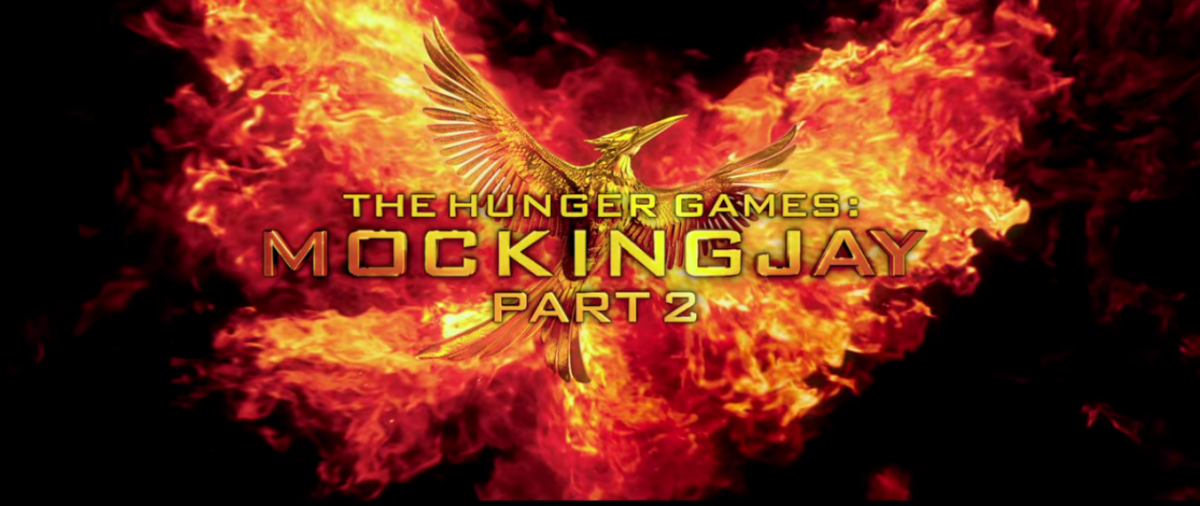Disclaimer: This review contains spoilers for “Mockingjay, Part II.”
As the fourth and final installment of the “Hunger Games” movie franchise, “Mockingjay Part II” scrambles to give a grim, satisfying end to the resolution to the series. Starting immediately from where Part I left off, we are immediately introduced once more to protagonist Katniss Everdeen, portrayed by Jennifer Lawrence, as she has finally recovered from a violent interaction with fellow friend and Hunger Games victor Peeta Mellark, as portrayed by Josh Hutcherson. We meet a physically battered and bruised Katniss, in what we’re led to assume is a low point in her role as a symbol for the ongoing thirteen-district revolution against the Capitol, led by President Snow (Donald Sutherland). The film does a good job of showing Katniss’ conflict with following her own desires and making uneasy allegiances with President Coin (a silver-haired, coldeyed Julianne Moore), commander of District 13 and the original conceiver of the revolution. Katniss’ and Coin’s goals partially overlap, however, which is both a source of unification and tension between the two.
Despite author Suzanne Collin’s crisp writing style, expected from a previous a television writer, adapting the book for the screen didn’t come without challenges. Unlike the previous books, the last half of Mockingjay is comprised largely of Katniss’ thoughts and internal turmoil as she watches a bloody revolution unfold, one that she is both helpless to control and extremely aware of how she has perpetuated it. Here lies the most compelling conflict of “Mockingjay,” which the film did a fine job illustrating, no doubt helped by Jennifer Lawrence’s acting abilities.
Another challenge was reminding the audience of Coin’s plans and motivations, which was less of a presence in the book. In its attempt to keep the audience in the loop, however, the film does hold the viewer a bit too firmly by the hand. The whole plot thread was just too predictable, not only in foreshadowing who was going to die next–cue brotherly moments between Pollux and Castor (Elden Henson and Wes Chatham), Finnick’s (Sam Claflin) snicker at the (premature) announcement of his death on the television–but also the nature of the end plot twist. If the audience didn’t already know Katniss was going to kill Coin immediately after talking to Snow, they surely knew after Coin slowly opened her arms at Snow’s execution, essentially inviting Katniss to shoot her. Mockingjay Part II left little room for any speculation about what would happen next (Coin or Snow? Peeta or Gale?), instead opting to deliver critical plot points on silver platters.
I was curious about the pacing of this movie, as it’s a common issue among other movies split into multiple parts — “Harry Potter and the Deathly Hallows Part 1”, and “The Hobbit Parts 1-3”? “Mockingjay Part I” had a fair share of stiflingly slow scenes, and unfortunately Part 2 followed a similar pattern; the pacing felt awkwardly stilted. Scenes generally went on for far too long, from the prolonged sequence immediately following the death of Boggs (Mahershala Ali), or the terribly dragged out underground shots. It was hard to tell if the slow pacing was to build suspense or to increase the movie’s total running time. Either way, there were some anguished moments in the crowded theatre as we silently watched multiple members of Squad 451 struggle through a crawlspace in the sewage tunnels. The time spent watching Gale (Liam Hemsworth) carefully place his gun in the crawlspace could have been more productively used in developing sympathizable characters with points of tragic humanity, another aspect the film was lacking. In general, character development was relatively poor; we didn’t see enough of the characters to really feel for their deaths. Seeing Finnick die wasn’t as painful as it was in the book, perhaps due to the fact that he had fewer than two dozen lines in the film.
The Hunger Games films have drawn in an impressive range of seasoned actors and actresses, including the late Philip Seymour Hoffman as Gamemaker Plutarch Heavensbee and Donald Sutherland as President Snow. Jena Malone’s portrayal of Johanna Mason was just the right combination of casual flippancy and gritty humor. We caught an intense, satisfying glimpse of Jennifer Lawrence’s prowess as an actress when Katniss confronts Prim’s old cat Buttercup at the end of the film, and relished Snow and Katniss’ last interaction in the rose garden. It therefore comes as no surprise that another large asset to the movie was the acting, however limited to a rather uninspiring writing. The actors were all there, but I itched for more stirring scenes in a more elastic script. Many of the most powerful scenes—the vote for a last “symbolic” Hunger Games, ”I thought we had agreed never lie to each other”–were noticeably taken nearly line for line from the book.
A final criticism of the film is how it lightly jumped over Katniss traumatic haze post-Prim’s death, where in the book she listlessly glides between wanting to live and die, knowing that she’s going to be forever haunted by memories and guilt. It appears Hollywood still can’t make the ending too sad. But, we’re still given a grim ending, a satisfyingly realistic one; there are neither frills nor joyful tears. Mockingjay Part II succeeded in partially evoking the same kind of torn anguish present in the books, but for some fans, it may not be enough. But even the most diehard book loyalists will grudgingly concede at least a small breath of relief as we watched Katniss in the epilogue sitting in a glowing field– perhaps holding her baby a bit too stiffly, but finally, irrevocably safe.




